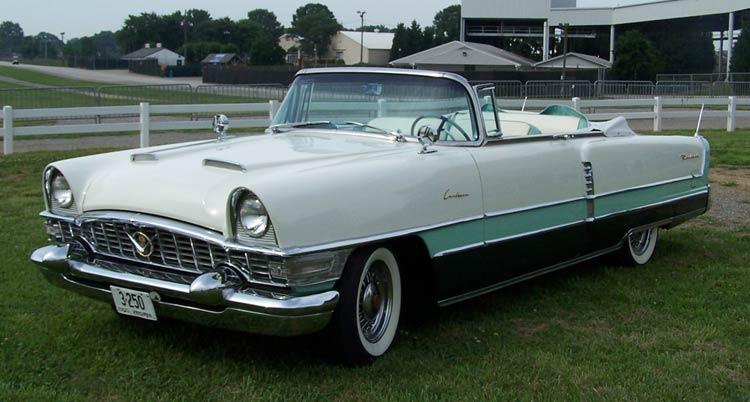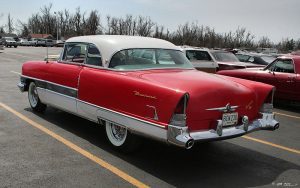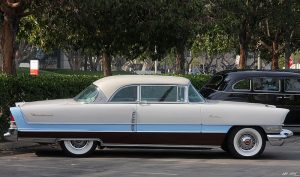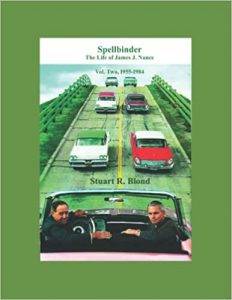
Why Packard Failed (2): The End of the Road, 1954-56
1954: Up the snake, down the ladder
Concluded from Part 1. This article first appeared in Collectible Automobile, December 2021.
The product mix that had done fairly well in 1953 continued. Senior Packards had a flashy new dash, optional four-way power seats and air conditioning, and a special nylon matelassé interior for the Patrician. Henney continued to build long-wheelbase models, along with funeral coaches and flower cars on the commercial chassis. While no Derham formal sedan was catalogued, some Patricians were so converted at the Derham shops. Edging toward the status of a separate make, Clippers were distinguished by more distinctive styling and referred to mainly by the Clipper name.
The Patrician’s new 359 nine-main bearing, 212 hp eight also found its way to the Caribbean, convertible and hardtop (now the Pacific). That made them luxury cars by every measure except wheelbase. They were priced accordingly: around $4000 for the Pacific and convertible, $6100 for the Caribbean. The latter lost its rear wheel cutouts while gaining a curious two-toning strip along the rear fenders. (Cadillac’s Eldorado, more “prodified” in 1954 and reduced by $2000, outsold it five to one.) Late in ’54, new Gear-Start Ultramatic offered the choice of the traditional leisurely torque converter acceleration or starting in low and automatically shifting to high.
Ford’s blitz, Studebaker’s curse
Unfortunately, just as the ‘54s were announced, car sales fell badly. On top of that came the infamous Ford-GM sales war, when Henry Ford II vowed to outproduce GM or sink trying. GM replied in kind. That meant shipping cars to dealers in greater quantity than they ordered. What it did was seriously to cripple Chrysler and the independents. Their dealers could not compete with giveaway prices offered by Ford and GM dealers crowded with inventory. Packard’s 1953 sales rally stopped cold as production fell to under 28,000 for the year.
The lack of a V-8 was part of this, and nervous dealers were complaining. Only Pontiac and Packard still offered in-line eights in 1954. An urgent V-8 program was underway. “We have no choice,” Nance groused. “Making one is the only road to a modern car. Everything follows the product.” He meant that every one followed the product. And a V-8 was the essential product for high-priced cars now.
On 1 October 1954, Packard purchased Studebaker in South Bend, Indiana. One week later, in an irony Jim Nance would ponder in later years, George Mason died. His successor, George Romney, had his own vision for American Motors. It did not include partners. So here was Nance, pursuing Mason’s dream of merging the independents, which had died with him. Buying Studebaker was decision at last, taken at the worst possible time. Packard’s chief financial officer, Walter Grant, studied Studebaker’s accounts and returned to Detroit “ashen-faced.” Instead of the 165,000-unit breakeven point quoted in sale negotiations, Studebaker needed 282,000 cars a year to be profitable. The closest it had come was 268,000 in 1950. “It was a kick in the gut,” Nance said later. “Their labor costs were substantially out of line.”
1955: One last try

The 1955 senior Packards, a deep facelift of the aging Reinhart body, were nicely improved. Onto that old shell, stylist Dick Teague grafted “cathedral” tail lights, peaked front fenders, an ornate grille and wraparound windshield. Henney had expired and long-wheelbase models were gone. So were the Derham formals, though Nance had tried to develop one. The underwhelming, middle-priced Cavalier was gone, and not missed. What remained, however, were a dramatic Caribbean and Patrician, and the new Four Hundred—at last a senior hardtop on the 127-inch wheelbase.
Attractive in the over-decorated mid-Fifties sense, they were blessed with power. Packard’s long-awaited V-8, a short-stroker of 352 cubic inches, delivered up to 275 hp in the Caribbean. For faster starts, Twin Ultramatic, an evolution of Gear-Start, offered the traditional torque convertor start or starting in low, shifting to 1:1 and then to direct drive. Special torque convertor vanes enhanced performance on Caribbeans and Four Hundreds. It was good transmission, though not up to the torque of the new V-8. Poorly serviced, or abused in stop-light grands prix, it often proved troublesome.
“Different from any other car”
The real marvel for 1955 was “Torsion-Level” suspension, designed by a brilliant engineer named Bill Allison. Long torsion bars longitudinally connected the front and rear wheels. A complex electrical leveling system adjusted for load. (We kids liked to pile into a Packard, riding up and down as the suspension compensated). Effectively interlinking all four wheels, Torsion-Level offered extraordinary ride and handling, standard on the seniors and upper-priced Clippers. Road testers loved it. Floyd Clymer proclaimed the Patrician “different from any other car…You can drive into a corner at high speed with this car and the body remains almost level.”
Such praise seemed to vindicate James Nance’s efforts to revive Packard’s luxury tradition. But in one respect, as the ’55s started production, he’d made a cardinal error. Since 1940 Packard bodies had been built by Briggs. In 1954 Briggs was bought by Chrysler, forcing Packard to build its own bodies. Badly advised, Nance settled for a cramped body plant on Conner Avenue, Detroit. Resultant production slowdowns and quality-control problems bedeviled the ’55s and enraged dealers. Chief complainant was Nance himself: “One Patrician was so bad I couldn’t begin to itemize…. It was literally necessary to use a crowbar to get one of the rear doors open.”
A “conditioning line” was set up to correct defects, but the shortage of flawless cars found dealers receiving too many dull green or blue jobs, instead of what they really wanted: fire opal, tourmaline or rose quartz. Glitzy styling, V-8 power and Torsion-Level could not compensate for such lapses. Packard and Clipper did produce 55,000 ’55 models, 30% of them luxury senior models. But anything would have been better than ’54. Nance had hoped for double that, and worse news was ahead.
1956: End of the luxury Packards
Conner’s problems were eventually surmounted and ironically the ’56s were much better built, with a sharp facelift, vivid paint jobs and a new Caribbean hardtop. Their bored-out 374 V-8 packed an industry-high 310 bhp in the Caribbean, which featured unique seat covers that could be removed and reversed from fabric to leather. Still, between Studebaker’s well-known struggles and Packard’s past quality problems, customers were deserting in droves. Scarcely 10,000 seniors were built for 1956—last of the “true” Packards.

Nance made strenuous efforts to finance a line of all-new cars with luxury Packards truly distinctive from the rest, but lenders had grown cautious. The Detroit plant closed, and Packard ended life as a glorified Studebaker, built in South Bend in 1957-58. Nance hung around long enough to place his top colleagues, which was greatly to his credit. Of course he was blamed for the debacle; the man at the top always is.
Why Packard failed
In reality, Packard’s crucial mistakes occurred years before. After the war, when a company could sell anything on wheels, Packard could have reverted to type, rebuilding its reputation as a luxury automaker. Instead it pursued the lower-priced markets that had saved it in the Depression. One can understand the reasoning—but there was no Depression now, and fierce competition soon engulfed those markets. In retrospect, if middle-priced cars were essential, there had been a better way: an entirely separate make not bearing the Packard name. But no one in 1945 could visualize that in the face of an American market clamoring for cars.
Stemming from this marketing mistake was a series of product decisions that flew in the face of Packard’s proud heritage. Instead of building on the timeless styling of the 1942 Clipper, still fresh after the war, management decreed a facelift that looked fine in 1948 but didn’t age well. Advertising was schizophrenic. Packard frequently changed agencies, some extolling luxury but most devoted to 200s or Clippers.
“Love me, love my dog”
Product mistakes came thick and fast. While Cadillac was creating the iconic Coupe de Ville, Packard built a station wagon—a very fine one, but a wagon? Packard needed a luxury hardtop in 1948, not 1955. While Cadillac was corralling the limousine market with its Fleetwood 75, Packard was edging away from it. Soon after the war, Cadillac adopted a modern V-8 and hallmark styling. “Cad fins” were so popular they became accessories for other makes. Packard stayed too long with fast-aging designs and inline engines. It was really a case of “love me, love my dog.” The public, or at least some of it, had always loved Packard. But they didn’t love the dog.
Nance and his colleagues didn’t know it, but even before they bought Studebaker, the song had ended. The melody lingered on in 1956, with impressive power, snazzy styling. Torsion-Level was innovative, typical of the engineering that had built Packard’s reputation since the 1900s. But the end finally came for the cars Tom McCahill knew as a boy, and we would never see their like again.
Further reading
“The Packard—Ne Plus Ultra of Automotive House Organs” (in two parts), 2021
“Packard Tales and Memories of Bud Juneau,” 2021
“Why Studebaker Failed: In the End, It is Always Management,” 2020
“Dutch Darrin, Part 2: The Packard Adventures,” 2017
Spellbinder: The Life of James Nance, by Stuart Blond
 The most comprehensive account of Nance’s tenure at Packard is in Stuart Blond’s new two-volume biography, which is strongly recommended for car enthusiasts old and new. Stuart, my successor as editor of The Packard Cormorant, has constructed a fastidious account of a Horatio Alger story, and how Nance ended up at Packard with the toughest challenge of his career.
The most comprehensive account of Nance’s tenure at Packard is in Stuart Blond’s new two-volume biography, which is strongly recommended for car enthusiasts old and new. Stuart, my successor as editor of The Packard Cormorant, has constructed a fastidious account of a Horatio Alger story, and how Nance ended up at Packard with the toughest challenge of his career.







6 thoughts on “Why Packard Failed (2): The End of the Road, 1954-56”
Packard became a laughing stock with its weak transmission and odd suspension that failed at the most inopportune times.I always thought the 1956 Patrician was the best looking car of that time and with a standard and overdrive would be a great road car.I bought a 1955 Patrician in 1958 for $880 and it was a bad idea. Weak brakes were another problem even when properly adjusted. Weighed and found wanting, Packard was dead by self inflicted wounds.
–
Glad you’re so sure of yourself. Actually the damage was done long before 1955-56, as I tried to explain. But transferring production to the small, cramped Conner Avenue plant in 1955 definitely affected quality. Ultramatic was one of the best early automatics, but adopting it to high-powered V8s was tricky and caused reliability problems. As for brakes, all American cars of that era were overbodied and underbraked. The ’55 Patrician was a noble effort, but it was still a facelift of the aging 1951 “high pockets” body, and the public could see that. -RML
“Packard’s Speedster”: This brings to mind my former self who has loving memories of speeding across Canada on the open road with Dan driving his first Porsche. This happy memory is very vivid, but now I can barely stand driving with him even on country roads. When I hear the acceleration from his heavy foot, I tense up. Oh well.
Also I enjoyed the article on why Packard failed. The Marxists, or whatever they are calling themselves these days, have zero understanding of the entrepreneurial risk others have taken in the past to benefit the life we have today. Sadly, most have ultimately failed as times change, which I feel is the ultimate sacrifice to the cause.
Richard, I hope you write “Why Hudson Failed”! One of the chapters should be pretty easy to compose, only needs two words: The Jet.
The sad thing about the four Independents is that by 1955-56 they collectively only needed one competitive small body shell and OHV Six, and one competitive large body shell and OHV V8. The money they wasted going it alone could have easily produced these. Fortunately for Nash/AMC and due entirely to Romney, it had that competitive small car in the ’56 Rambler.
I don’t think there was a pure luxury play for Packard with the advent of all-steel bodies. Even in the 1920s with its wood composite bodies, Packard needed the Six for volume. The ’48 Cadillac 62 and Oldsmobile 98 shared a common body shell, economies of which set pricing for both. The 60 Special shared this shell too, moved forward 7 inches relative to rear axle, and used a unique backlight/roof cutout. A few years later, Buick replaced Oldsmobile as the sharing partner with Cadillac. For Packard to match these programs it needed to establish similar pricing bandwidth and scale, and the dealers needed a volume car.
Rereading one of the books on my bookshelf by a fine gent with initials RL… I see that Hudson spent $16M to create the ’48 Step-Downs. Three years later, Packard spent around $18.6M (“Packard 1951 To 1954” by Robert J. Neal). Given those inflationary years, the two programs were roughly equivalent in cost, so the reality was that Monobilt was no more expensive to create than BoF. As to restyling cost, again not much difference if the ’54 Hudson is any indication. And the reality was that Cadillac didn’t restyle its cars much at all from 1950-53, though it did convert the CdV to long deck for ’52.
Given that Alvan Macauley was open to merger in the late ‘40s, having allowed Mason to offer a proposal to Packard in February 1948, I can envision a scenario where Packard and Hudson merged immediately after the war, with Monobilt becoming a joint program and Briggs becoming history.
With Clipper as guidance, Packard’s styling contribution could have been to change Hudson’s traditional (and antiquated) body proportion mindset from 2-1/2 box to 3-box, the sedan’s greenhouse from 6-window to 4-window, and the sedan’s rear overhang to a longer one that used the coupe’s longer decked. The shorter roof coupe would need to sit on a shorter wheelbase if it were to share the sedan’s decklid and end panel.
Packard would have used a longer axle-to-dash to package its big Eights, and created its own front appearance and interiors, all of which would have enabled it to focus exclusively on the luxury market. Ultramatic would arrive in ’49, a V8 in ’51 if a reaction to the ’49 Olds/Cadillac V8s, or ’53 if it took ’51 Chrysler’s V8 to finally get EGB off its duff. Dealers would dual where it made sense.
–
Paul- Good thoughts. These are deep waters. Doesn’t it come down to the same thing? Too many “independents” thrashing around, duplicating efforts and competing with each other. If only they’d listened to George Mason in 1948. Ah, if only! RL
Would Packard for 1955 have done better with the new V8 and modified body, or a carried-over 359 Eight powering a spectacular, all-new new body? By mid-1953 after the sellers market had ended, it had come down to a binary choice.
Considering the success of Lincoln’s longer, lower, wider bodies for 1956, I would argue the latter. A stellar looking 1955 Packard showroom, still with Torsion-Level, would quite possibly have generated sales sufficient to finish the tooling for the V8 and launched it in ’56.
However, there were two complicating factors. The first was that Hudson had approached Packard around August 1953 expressing a willingness to merge, with Hudson the weaker bargaining partner. The second was that Chrysler informed Packard in October 1953 that it had purchased Briggs and that Packard had to exit the Conner body plant by the end of the year (that date was quickly extended to the end of 1954).
Considering everything, including the helpful addition of Hudson’s dealers, I think Packard’s best option might have been to merge with Hudson. Why? Because Hudson already had a body operation and a lower car, underpinning of which would have given the new Packard-Hudson company a running start on an all-new, lower body for ’55. Frank Spring’s X-161 4-door prototype hinted at the possibilities.
The new company would have billed itself as a marriage between the Master Motor Builder and the Master Body Builder, and the company would have had a strong case to make to investors, money of which would have helped to carry the company through a difficult 1954 model year and to tool the ’55s.
The fact that Hudson also sold a poorly designed compact car (the Jet) could have also proved helpful, its greatest value perhaps to underpin a cool looking, affordable 2+2 coupe 10 years before Mustang.
Packard-Hudson would have also been in a strong position to bargain with Nash for an advantageous merger. Or perhaps Nash would have redirected its merger energies towards fast-weakening Studebaker, with both ships quickly righted with the ’56 Rambler redesign.
=
Thanks Paul, for taking the trouble to offer a thoughtful what-if. I think myself it’s unlikely. The personalities weren’t right: Nance only came to Packard because Mason told him he’d pick up Hudson while Nance got Studebaker. (If Ed Barit at Hudson approached Packard in 1953 it must have been an afterthought, since Mason had been pursuing Hudson since the late 40s.) That was the flaw in Mason’s plan, because Stude was an albatross best left out, impossible to break even. Product-wise, Hudson was in even worse shape than Packard, with a body dating three years before Packard’s and almost impossible to restyle, competing closely with the multitude of cheaper Packards—and losing dealers. The homely Hudson Jet was no competition to Rambler. Nance knew that sales-wise, a V8 was crucial, but by 1955 it was too late. If Packard had reverted to pure luxury in 1946, kept Clipper styling through 48, did your snazzy restyle in 49 and a V8 in 50, then maybe. You are astute to suggest the X-161 might have developed into a popular 2+2 sporty car well before Mustang (or the Squarebird). But it was never more than a wistful dream. I think I must now write “Why Hudson Failed.” —RML
Stuart Blond has told a very interesting story about James Nance. It took two volumes because Nance’s life of marketing, and why he made those decisions, is very involved from one company to another. In vol. 2, Stuart explains that Nance was a warm human being, who cared for the workers at Packard and Ford He wanted Packard and Edsel to succeed in the marketplace.
Fascinating article on Packard and cars of the 50s like Studebaker. I heard about these cars from my father who was (unfortunately for him) a part owner of a DeSoto dealership in New Jersey. My father always bought whenever possible an American made car.We had a 1954 Ford for over 20 years. It still ran great in the early 1970s but due to some rust (From salted roads) it was almost impossible to get passed by the NJ DMV (they had physical inspections in those day). Of course today there is probably no such thing as an American made car just a hybrid of international parts. Very interesting and comprehensive article.
–
Thanks. In 1955 I wanted my Dad to buy an Aero-Willys. No way, he said, “they’re going out of business, it would become an orphan.” So he bought a DeSoto….. —RML
Comments are closed.